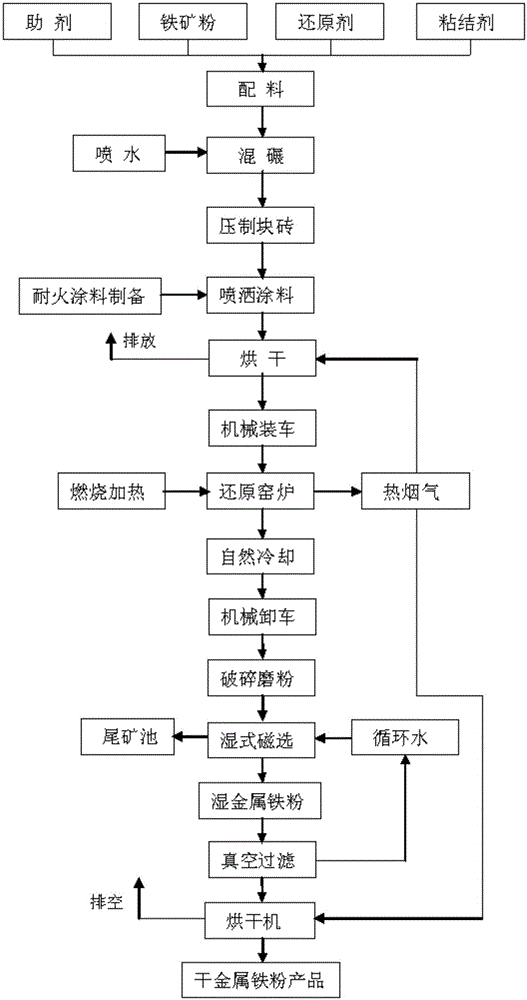Method for separating and reducing iron powder from refractory mineral, complex ore and iron-containing waste materials
A technology for reducing iron powder and compound ore, applied in the field of metallurgy, can solve the problems of low product quality, high labor consumption, high energy consumption, and achieve the effect of high recovery rate
- Summary
- Abstract
- Description
- Claims
- Application Information
AI Technical Summary
Problems solved by technology
Method used
Image
Examples
Embodiment 1
[0027] A method for separating and reducing iron powder from refractory ore, compound ore and iron-containing waste, the steps are as follows:
[0028] (1) select 200 orders and account for 90%, grade TFe:56.46% Inner Mongolia sulfate slag ore powder, add reductant, auxiliary agent and bentonite, the weight ratio of described ore powder, reductant, auxiliary agent and bentonite is 65: 22:12:1.0, then add quartz sand with a particle size of 3-6mm and 5% of the mass of mineral powder, and scrap steel chips with a length of 3-10mm and 5% of the mass of mineral powder, and mix evenly;
[0029] (2) Spray 5.0% water of mineral powder mass in the mixed mineral powder of step (1), make mineral powder into bricks of 230×115×65mm, spray a layer of 1.5mm on the surface of mineral powder bricks after drying Thick refractory coating layer, dry in a drying kiln at 180°C for 4.0h;
[0030] (3) Spread anthracite coal powder with a thickness of 10mm on the kiln car, place the bricks in step (...
Embodiment 2
[0035] A method for separating and reducing iron powder from refractory ore, compound ore and iron-containing waste, the steps are as follows:
[0036] (1) select TFe:45.46% Hunan oolitic hematite, be ground into about 80 purpose mineral powders, add reducing agent, auxiliary agent and glass water, the weight ratio of described mineral powder, reducing agent, auxiliary agent and glass water 66:20:13:1.0, then add waste refractory brick particles with a particle size of 3-6mm and 6% of the mass of mineral powder, and scrap steel chips with a length of 3-10mm and 4.5% of the mass of mineral powder, and mix evenly;
[0037] (2) Spray 5.0% water of mineral powder mass in the mixed mineral powder of step (1), make mineral powder into bricks of 230×115×65mm, spray a layer of 1.5mm on the surface of mineral powder bricks after drying Thick refractory coating layer, dry in a drying kiln at 180°C for 4.0h;
[0038] (3) Spread anthracite coal powder with a thickness of 10mm on the kiln...
Embodiment 3
[0044] A method for separating and reducing iron powder from refractory ore, compound ore and iron-containing waste, the steps are as follows:
[0045] (1) select TFe:40.26% Linjiang antelope iron ore, grind into 0~80 purpose ore powder, add reductant, auxiliary agent and lime powder, the weight of described ore powder, reductant, auxiliary agent and lime powder The ratio is 64:22:12.5:1.5, then add quartz sand with a particle size of 3-6mm, 4% of the mineral powder mass, and scrap steel scraps with a length of 3-10mm and 3.5% of the mineral powder weight, and mix evenly;
[0046] (2) Spray 5.0% water of mineral powder mass in the mixed mineral powder of step (1), make mineral powder into bricks of 230×115×65mm, spray a layer of 1.5mm on the surface of mineral powder bricks after drying Thick refractory coating layer, dry in a drying kiln at 105°C for 4.0h;
[0047] (3) Spread 10mm of anthracite coal powder on the kiln car, place the bricks in step (2) evenly on the kiln car ...
PUM
| Property | Measurement | Unit |
|---|---|---|
| particle size | aaaaa | aaaaa |
| particle size | aaaaa | aaaaa |
Abstract
Description
Claims
Application Information
 Login to View More
Login to View More - R&D
- Intellectual Property
- Life Sciences
- Materials
- Tech Scout
- Unparalleled Data Quality
- Higher Quality Content
- 60% Fewer Hallucinations
Browse by: Latest US Patents, China's latest patents, Technical Efficacy Thesaurus, Application Domain, Technology Topic, Popular Technical Reports.
© 2025 PatSnap. All rights reserved.Legal|Privacy policy|Modern Slavery Act Transparency Statement|Sitemap|About US| Contact US: help@patsnap.com



